tailgate MINI Countryman 2015 (Mini Connected) User Guide
[x] Cancel search | Manufacturer: MINI, Model Year: 2015, Model line: Countryman, Model: MINI Countryman 2015Pages: 283, PDF Size: 6.76 MB
Page 113 of 283

MINI Paceman
Take out the cover.
Cargo area Cargo cover Do not place objects on the covers
Do not place objects on the cover; if you
do so, they may pose a danger to vehicle occu‐
pants during braking or evasive maneuvers or
damage the cover. ◀
Move the cover into position
When closing, ensure that the cargo cover
is resting on the rubber buffers of the securing
straps; otherwise, damage may occur when
closing the tailgate. ◀
When the tailgate is opened, the cargo cover is
raised.
To load bulky luggage, the cover can be re‐
moved.
1.Detach the securing straps from the tail‐
gate.2.Lift the cover slightly, arrow 1, and pull it
back and out of the bracket, arrow 2.
MINI Countryman:
MINI Paceman:
MINI Countryman: rear seat backrests
Danger of pinching
Before folding down the rear seat back‐
rests, ensure that path of movement of the
backrests is clear. Especially when the middle
section is folded down, ensure that no one is
located in or reaches into the path of move‐ ment of the rear seat backrests. Otherwise, in‐
juries or damage may result. ◀
Observe the instructions concerning the
safety belt
Observe the instructions concerning the safety
belt, refer to page 46. Otherwise, personal pro‐
tection may be compromised. ◀
The rear seat backrest is divided at a ratio of 40-20-40.
When the outer rear seat backrests are folded down, it is not permissible for a person to travel
on the center seat.
Remove the third head restraint, refer to
page 49, if necessary.
Seite 111Interior equipmentCONTROLS111
Online Edition for Part no. 01 40 2 961 110 - II/15
Page 115 of 283

partment during braking maneuvers and
swerving, endangering the occupants. ◀
Flat loading floor Maximum load
Do not exceed the maximum load of
330 lbs, 150 kg, on the loading floor; otherwise,
damage may result. ◀
Access to storage area
A storage area for items like the partition net is
found under the loading floor.1.Reach into the recess, arrow 1, on the rear
edge of the loading floor.2.Lift the loading floor at the rear, arrow 1,
and fold it forward, arrow 2.
MINI Countryman:
MINI Paceman:
Before closing the tailgate, lower the loading
floor back onto the cargo area floor.
Removing
The loading floor can be removed if necessary.1.Fold up the loading floor.2.Pull it back slightly and out of the holders.3.Then remove it upward.
The folded loading floor can be stored in the
cargo area.
MINI Countryman: partition net Firmly attach the partition net
Make sure that the partition net is firmly
attached; otherwise, injuries may result. ◀
Before installing
1.Remove the pouch with the partition net
from the storage compartment under the
loading floor in the cargo area.2.Take the partition net out of the pouch, un‐
roll it, and unfold it.
After use, fold and roll up the partition net
in the same manner and place it in the
pouch so that it can be stowed back under
the cargo floor panel. Ensure that hooks
and tensioning buckles do not rest on the
rod elements.3.Unfold the partition net to the point where
the rod elements engage.
Installation behind the front seats
1.Take out the cargo cover if necessary.2.Fold down the rear seat backrests, refer to
Enlarging the cargo area.Seite 113Interior equipmentCONTROLS113
Online Edition for Part no. 01 40 2 961 110 - II/15
Page 123 of 283
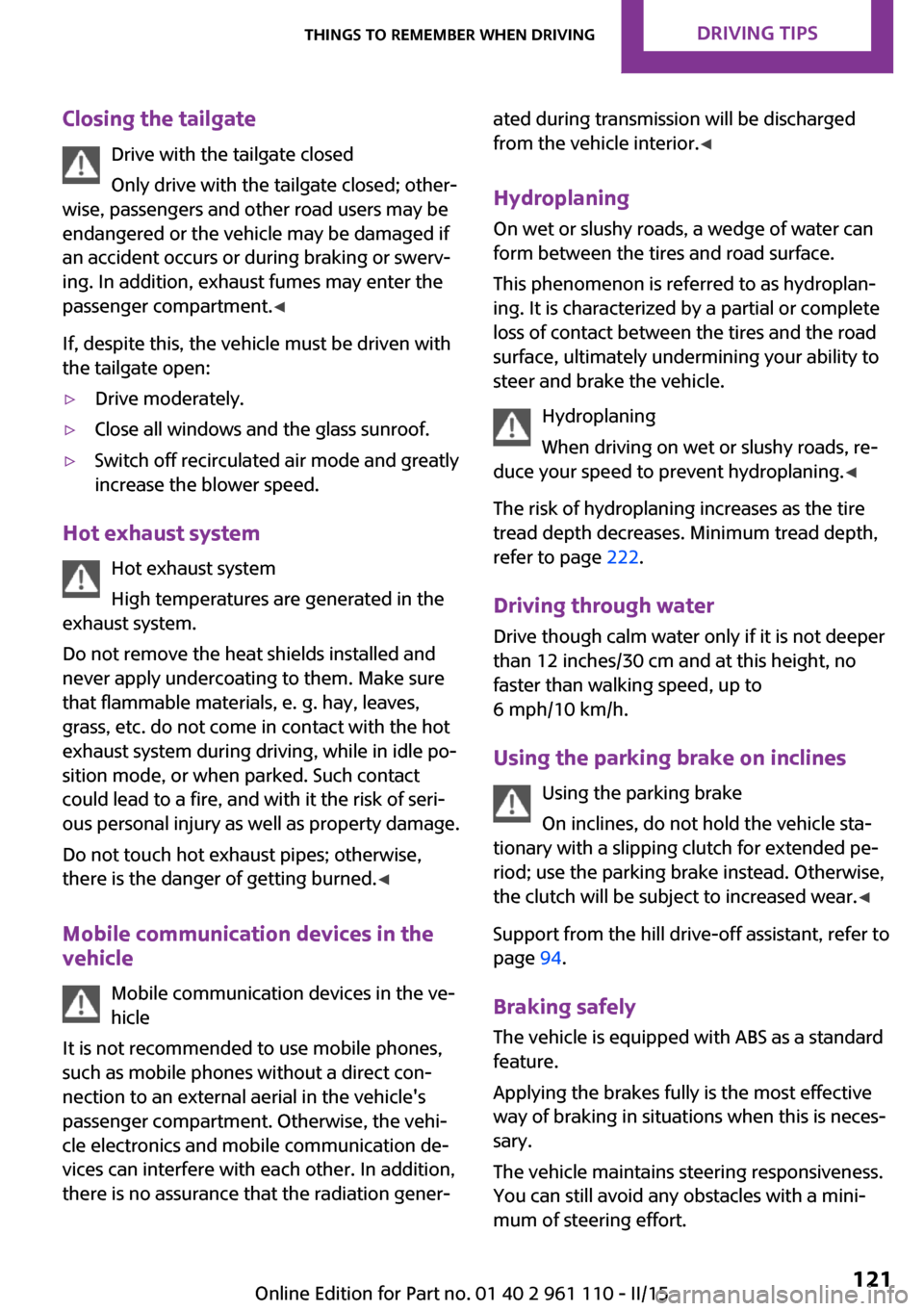
Closing the tailgateDrive with the tailgate closed
Only drive with the tailgate closed; other‐
wise, passengers and other road users may be
endangered or the vehicle may be damaged if
an accident occurs or during braking or swerv‐
ing. In addition, exhaust fumes may enter the
passenger compartment. ◀
If, despite this, the vehicle must be driven with
the tailgate open:▷Drive moderately.▷Close all windows and the glass sunroof.▷Switch off recirculated air mode and greatly
increase the blower speed.
Hot exhaust system
Hot exhaust system
High temperatures are generated in the
exhaust system.
Do not remove the heat shields installed and
never apply undercoating to them. Make sure
that flammable materials, e. g. hay, leaves,
grass, etc. do not come in contact with the hot
exhaust system during driving, while in idle po‐
sition mode, or when parked. Such contact
could lead to a fire, and with it the risk of seri‐
ous personal injury as well as property damage.
Do not touch hot exhaust pipes; otherwise,
there is the danger of getting burned. ◀
Mobile communication devices in the
vehicle
Mobile communication devices in the ve‐
hicle
It is not recommended to use mobile phones,
such as mobile phones without a direct con‐
nection to an external aerial in the vehicle's
passenger compartment. Otherwise, the vehi‐
cle electronics and mobile communication de‐
vices can interfere with each other. In addition,
there is no assurance that the radiation gener‐
ated during transmission will be discharged
from the vehicle interior. ◀
Hydroplaning On wet or slushy roads, a wedge of water can
form between the tires and road surface.
This phenomenon is referred to as hydroplan‐
ing. It is characterized by a partial or complete
loss of contact between the tires and the road
surface, ultimately undermining your ability to
steer and brake the vehicle.
Hydroplaning
When driving on wet or slushy roads, re‐
duce your speed to prevent hydroplaning. ◀
The risk of hydroplaning increases as the tire
tread depth decreases. Minimum tread depth,
refer to page 222.
Driving through water Drive though calm water only if it is not deeper
than 12 inches/30 cm and at this height, no
faster than walking speed, up to
6 mph/10 km/h.
Using the parking brake on inclines Using the parking brake
On inclines, do not hold the vehicle sta‐
tionary with a slipping clutch for extended pe‐
riod; use the parking brake instead. Otherwise, the clutch will be subject to increased wear. ◀
Support from the hill drive-off assistant, refer to
page 94.
Braking safely The vehicle is equipped with ABS as a standard
feature.
Applying the brakes fully is the most effective
way of braking in situations when this is neces‐
sary.
The vehicle maintains steering responsiveness.
You can still avoid any obstacles with a mini‐
mum of steering effort.Seite 121Things to remember when drivingDRIVING TIPS121
Online Edition for Part no. 01 40 2 961 110 - II/15
Page 129 of 283
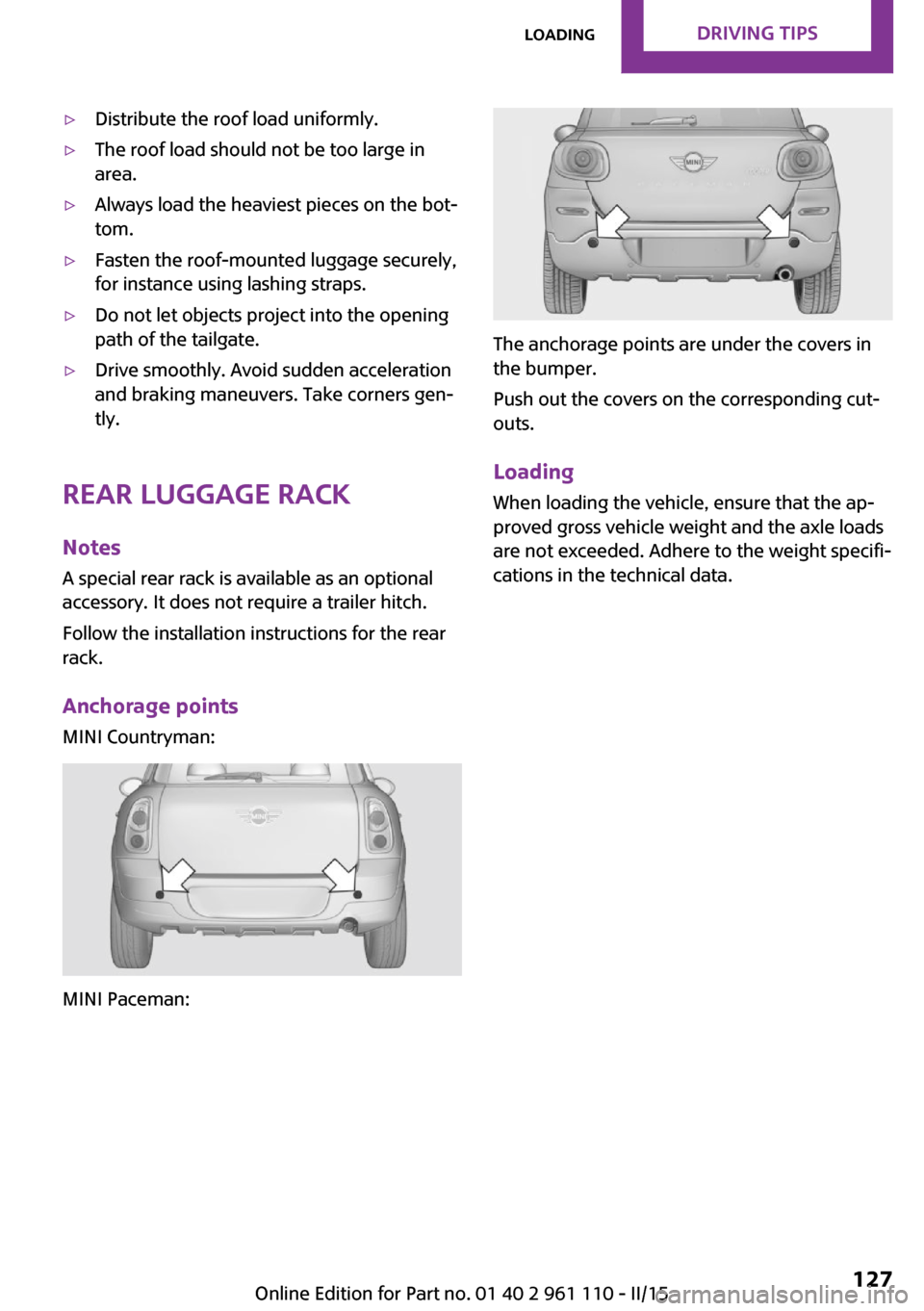
▷Distribute the roof load uniformly.▷The roof load should not be too large in
area.▷Always load the heaviest pieces on the bot‐
tom.▷Fasten the roof-mounted luggage securely,
for instance using lashing straps.▷Do not let objects project into the opening
path of the tailgate.▷Drive smoothly. Avoid sudden acceleration
and braking maneuvers. Take corners gen‐
tly.
Rear luggage rack
Notes A special rear rack is available as an optional
accessory. It does not require a trailer hitch.
Follow the installation instructions for the rear
rack.
Anchorage points
MINI Countryman:
MINI Paceman:
The anchorage points are under the covers in
the bumper.
Push out the covers on the corresponding cut‐
outs.
Loading
When loading the vehicle, ensure that the ap‐
proved gross vehicle weight and the axle loads
are not exceeded. Adhere to the weight specifi‐
cations in the technical data.
Seite 127LoadingDRIVING TIPS127
Online Edition for Part no. 01 40 2 961 110 - II/15
Page 242 of 283
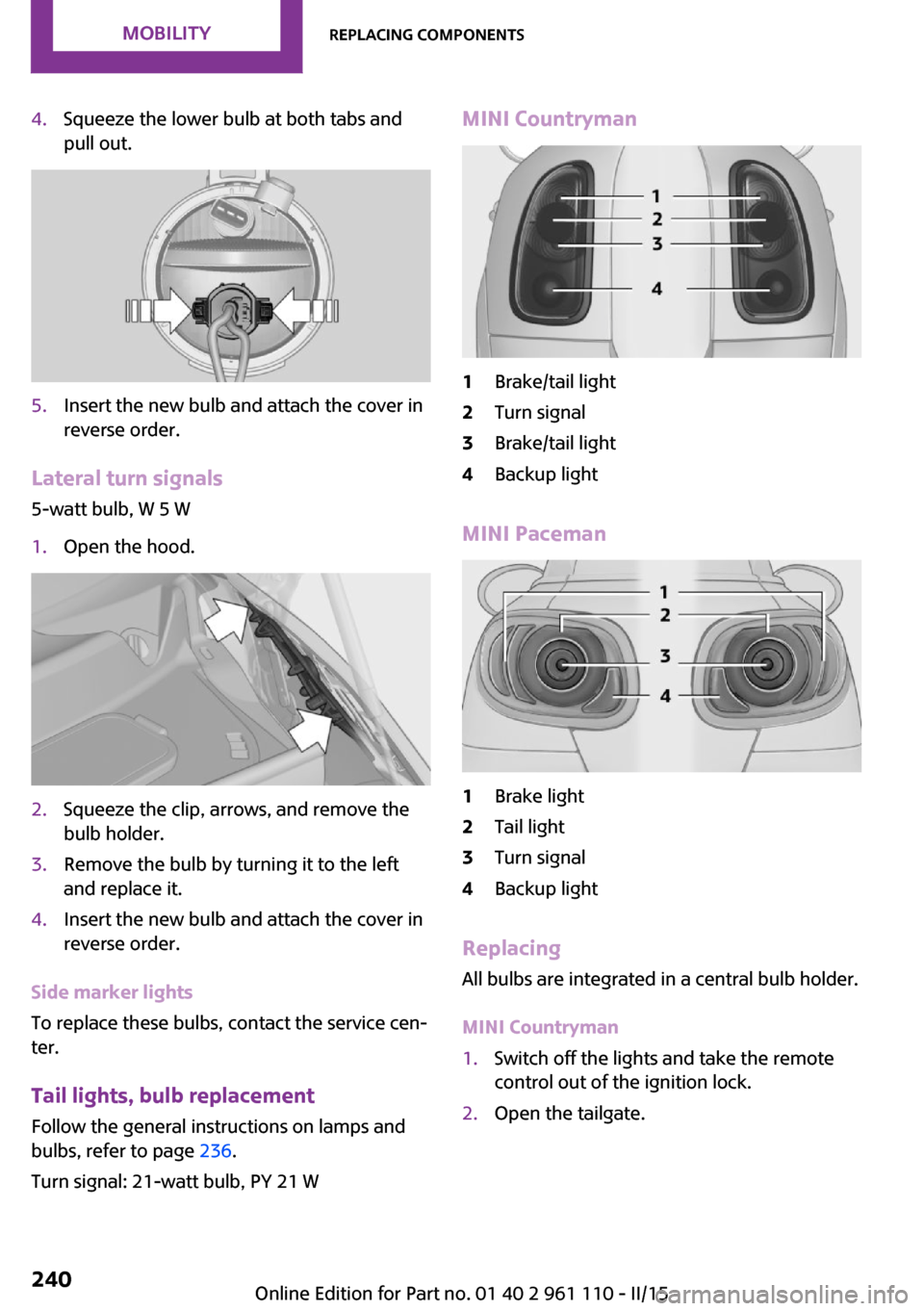
4.Squeeze the lower bulb at both tabs and
pull out.5.Insert the new bulb and attach the cover in
reverse order.
Lateral turn signals
5-watt bulb, W 5 W
1.Open the hood.2.Squeeze the clip, arrows, and remove the
bulb holder.3.Remove the bulb by turning it to the left
and replace it.4.Insert the new bulb and attach the cover in
reverse order.
Side marker lights
To replace these bulbs, contact the service cen‐
ter.
Tail lights, bulb replacement
Follow the general instructions on lamps and
bulbs, refer to page 236.
Turn signal: 21-watt bulb, PY 21 W
MINI Countryman1Brake/tail light2Turn signal3Brake/tail light4Backup light
MINI Paceman
1Brake light2Tail light3Turn signal4Backup light
Replacing
All bulbs are integrated in a central bulb holder.
MINI Countryman
1.Switch off the lights and take the remote
control out of the ignition lock.2.Open the tailgate.Seite 240MOBILITYReplacing components240
Online Edition for Part no. 01 40 2 961 110 - II/15
Page 243 of 283
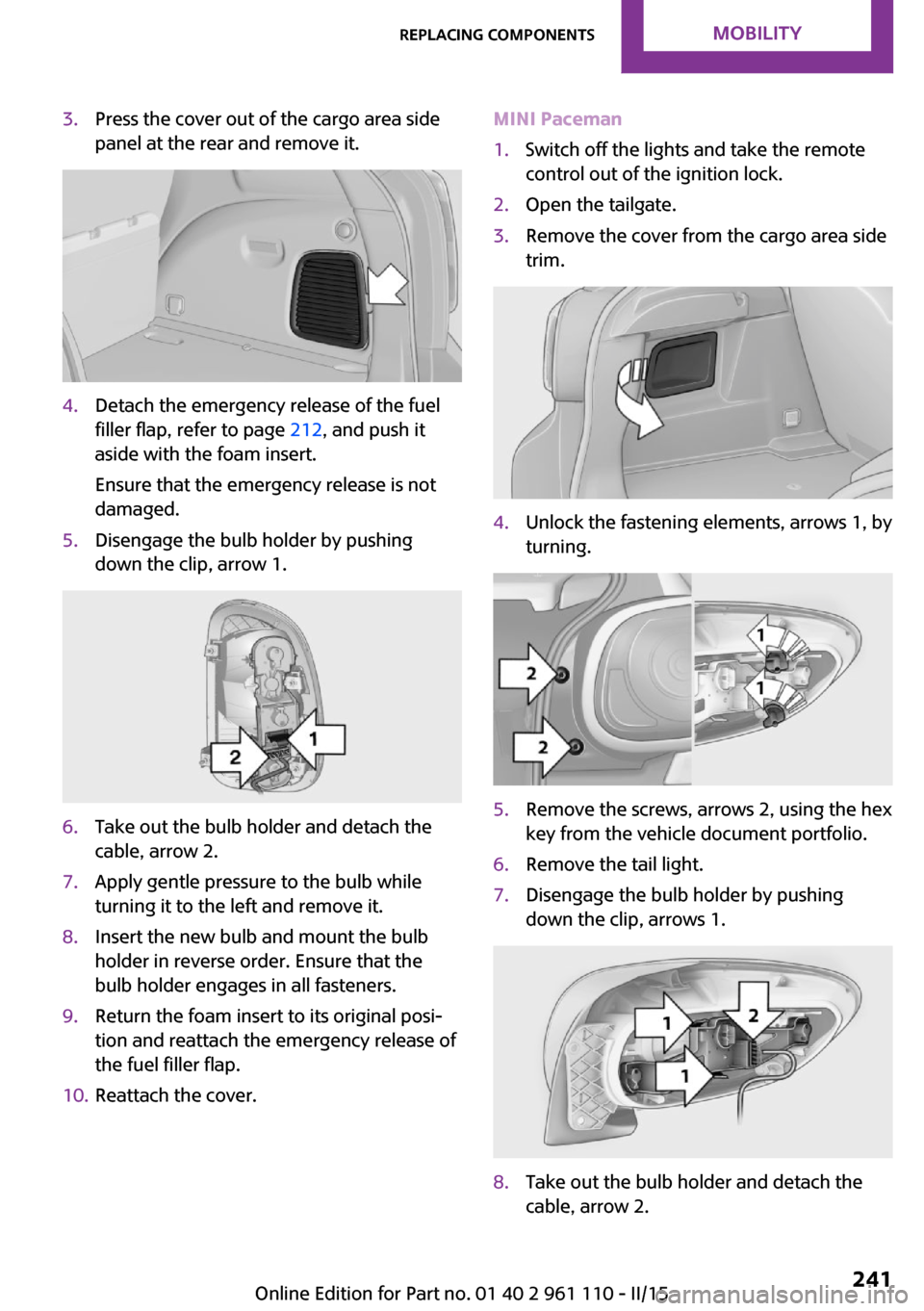
3.Press the cover out of the cargo area side
panel at the rear and remove it.4.Detach the emergency release of the fuel
filler flap, refer to page 212, and push it
aside with the foam insert.
Ensure that the emergency release is not
damaged.5.Disengage the bulb holder by pushing
down the clip, arrow 1.6.Take out the bulb holder and detach the
cable, arrow 2.7.Apply gentle pressure to the bulb while
turning it to the left and remove it.8.Insert the new bulb and mount the bulb
holder in reverse order. Ensure that the
bulb holder engages in all fasteners.9.Return the foam insert to its original posi‐
tion and reattach the emergency release of
the fuel filler flap.10.Reattach the cover.MINI Paceman1.Switch off the lights and take the remote
control out of the ignition lock.2.Open the tailgate.3.Remove the cover from the cargo area side
trim.4.Unlock the fastening elements, arrows 1, by
turning.5.Remove the screws, arrows 2, using the hex
key from the vehicle document portfolio.6.Remove the tail light.7.Disengage the bulb holder by pushing
down the clip, arrows 1.8.Take out the bulb holder and detach the
cable, arrow 2.Seite 241Replacing componentsMOBILITY241
Online Edition for Part no. 01 40 2 961 110 - II/15
Page 279 of 283

Spoken instructions, naviga‐tion 145
Sport button 94
Sport program, Steptronic transmission 65
Stability control systems 92
Start/Stop button 57
Start/Stop button, starting the engine 58
Start/Stop button, switching off the engine 59
Starting the engine 58
Start problems, refer to Jump- starting 245
State/province, selecting for navigation 134
Stations, stored 163
Station, storing 157
Status information, onboard monitor 21
Steering wheel 51
Steering wheel, adjusting 51
Steering wheel lock 57
Steering wheel, shift pad‐ dles 65
Steptronic transmission 64
Steptronic transmission, kick‐ down 65
Steptronic transmission, over‐ riding the selector lever
lock 66
Stopping, engine 59
Storage, tires 224
Storing the vehicle 254
Street, entering for naviga‐ tion 135
Summer tires, refer to Wheels and tires 216
Summer tires, tread 221
Sun visor 107
Switches, refer to Cockpit 12
Switching off, engine 59
Switching off, vehicle 59
Symbols 6 T
Tachometer 68
Tailgate 35
Tailgate, Comfort Access 37
Tailgate, opening/closing 35
Tailgate, opening from the outside 35
Tail lights 240
Tank gauge, refer to Fuel gauge 68
Tasks 204
Technical changes, refer to Safety 6
Telephone, adjusting the vol‐ ume, hands-free system 181
Telephone, adjusting the vol‐ ume, mobile phone prepara‐
tion package 193
Telephone, hands-free sys‐ tem 178
Telephone, mobile phone preparation 188
Temperature, air condi‐ tioner 100
Temperature, automatic cli‐ mate control 103
Temperature, changing the unit of measure 71
Temperature, coolant, refer to Coolant temperature 68
Temperature display– External temperature warn‐
ing 67
Temperature display, external
temperature 67
Temperature display, setting the units 71
Temperature warning 67
Text messages 202
Theft alarm system, refer to Alarm system 39
Tilt alarm sensor 40
Time, setting the time 71
Tire age 222
Tire, flat tire 85
Tire identification marks 220
Tire inflation pressure 216
Tire inflation pressure, pres‐ sure loss, FTM 85
Tire pressure loss, RDC 87
Tire, pressure monitoring, re‐ fer to Tire Pressure Monitor
TPM 86
Tire pressure monitor, refer to Flat Tire Monitor 84
Tire Pressure Monitor TPM 86
Tire Pressure Monitor TPM, system limits 89
Tire Pressure Monitor TPM, system reset 87
Tire Pressure Monitor TPM, warning lamp 87
Tire Quality Grading 220
Tires, breaking in 120
Tires, changing 223
Tires, condition 221
Tires, damage 222
Tire size 220
Tires, minimum tread 222
Tires, retreaded tires 223
Tires, storage 224
Tire tread 221
Toll roads, route 143
Tone 154
Towing another vehicle 247
Towing, being towed 247
Town/city, navigation 134
Tow-starting 247
TPM, refer to Tire Pressure Monitor 86
Traction control 93
Traffic bulletins, naviga‐ tion 147
Transmission lock, refer to Changing the selector lever
positions 64
Transmission, overriding the selector lever lock with Step‐
tronic transmission 66
Transmission, refer to Manual transmission 63 Seite 277Everything from A to ZREFERENCE277
Online Edition for Part no. 01 40 2 961 110 - II/15
Page 280 of 283
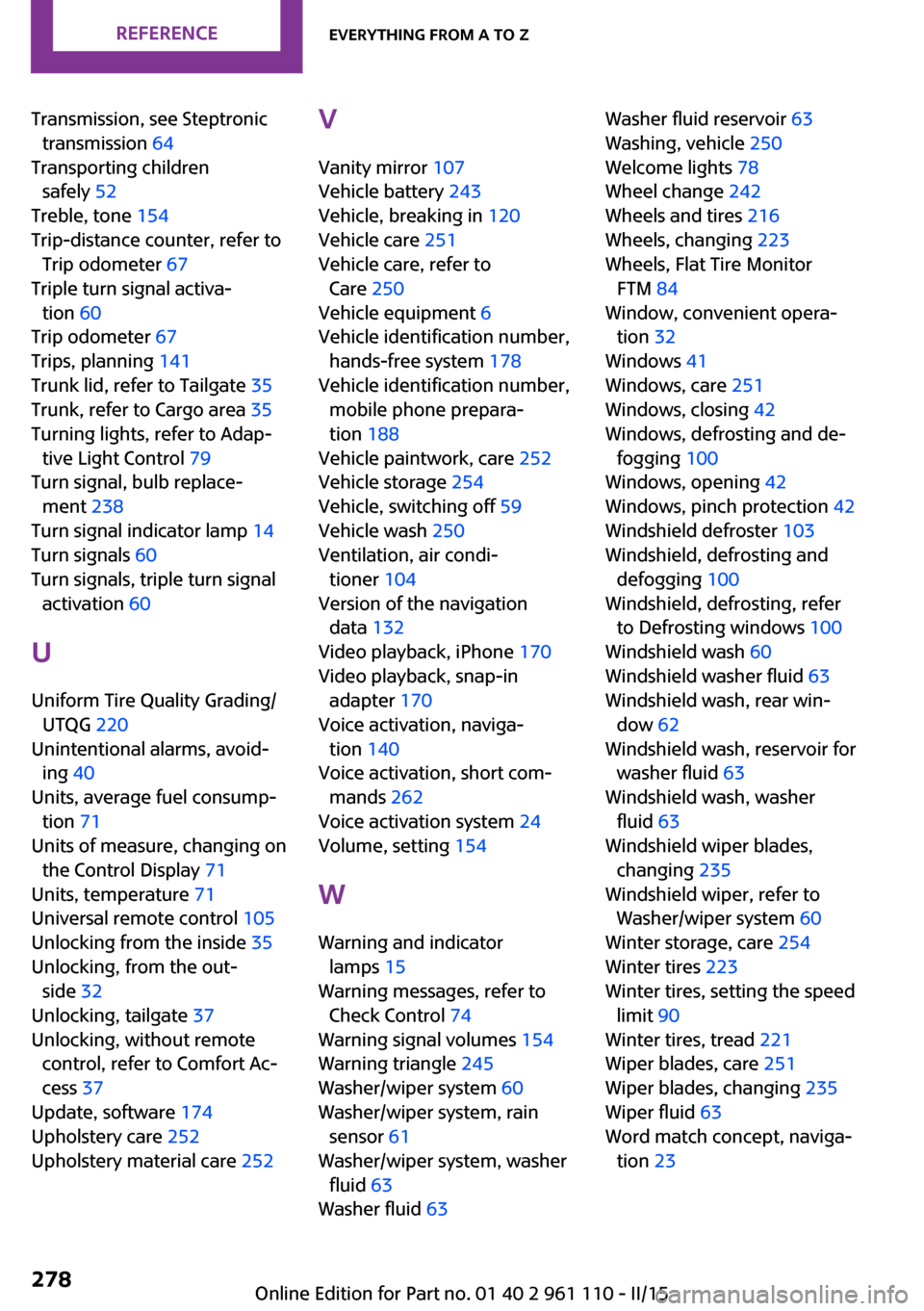
Transmission, see Steptronictransmission 64
Transporting children safely 52
Treble, tone 154
Trip-distance counter, refer to Trip odometer 67
Triple turn signal activa‐ tion 60
Trip odometer 67
Trips, planning 141
Trunk lid, refer to Tailgate 35
Trunk, refer to Cargo area 35
Turning lights, refer to Adap‐ tive Light Control 79
Turn signal, bulb replace‐ ment 238
Turn signal indicator lamp 14
Turn signals 60
Turn signals, triple turn signal activation 60
U
Uniform Tire Quality Grading/ UTQG 220
Unintentional alarms, avoid‐ ing 40
Units, average fuel consump‐ tion 71
Units of measure, changing on the Control Display 71
Units, temperature 71
Universal remote control 105
Unlocking from the inside 35
Unlocking, from the out‐ side 32
Unlocking, tailgate 37
Unlocking, without remote control, refer to Comfort Ac‐
cess 37
Update, software 174
Upholstery care 252
Upholstery material care 252 V
Vanity mirror 107
Vehicle battery 243
Vehicle, breaking in 120
Vehicle care 251
Vehicle care, refer to Care 250
Vehicle equipment 6
Vehicle identification number, hands-free system 178
Vehicle identification number, mobile phone prepara‐
tion 188
Vehicle paintwork, care 252
Vehicle storage 254
Vehicle, switching off 59
Vehicle wash 250
Ventilation, air condi‐ tioner 104
Version of the navigation data 132
Video playback, iPhone 170
Video playback, snap-in adapter 170
Voice activation, naviga‐ tion 140
Voice activation, short com‐ mands 262
Voice activation system 24
Volume, setting 154
W
Warning and indicator lamps 15
Warning messages, refer to Check Control 74
Warning signal volumes 154
Warning triangle 245
Washer/wiper system 60
Washer/wiper system, rain sensor 61
Washer/wiper system, washer fluid 63
Washer fluid 63 Washer fluid reservoir 63
Washing, vehicle 250
Welcome lights 78
Wheel change 242
Wheels and tires 216
Wheels, changing 223
Wheels, Flat Tire Monitor FTM 84
Window, convenient opera‐ tion 32
Windows 41
Windows, care 251
Windows, closing 42
Windows, defrosting and de‐ fogging 100
Windows, opening 42
Windows, pinch protection 42
Windshield defroster 103
Windshield, defrosting and defogging 100
Windshield, defrosting, refer to Defrosting windows 100
Windshield wash 60
Windshield washer fluid 63
Windshield wash, rear win‐ dow 62
Windshield wash, reservoir for washer fluid 63
Windshield wash, washer fluid 63
Windshield wiper blades, changing 235
Windshield wiper, refer to Washer/wiper system 60
Winter storage, care 254
Winter tires 223
Winter tires, setting the speed limit 90
Winter tires, tread 221
Wiper blades, care 251
Wiper blades, changing 235
Wiper fluid 63
Word match concept, naviga‐ tion 23 Seite 278REFERENCEEverything from A to Z278
Online Edition for Part no. 01 40 2 961 110 - II/15